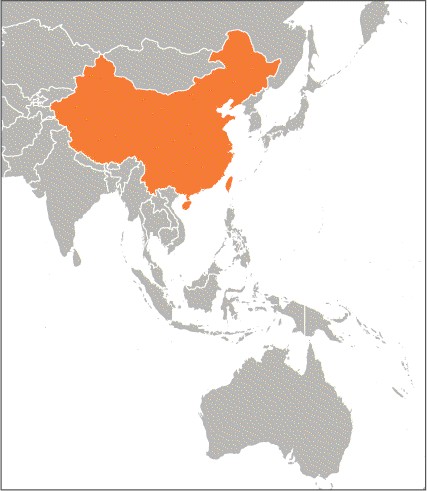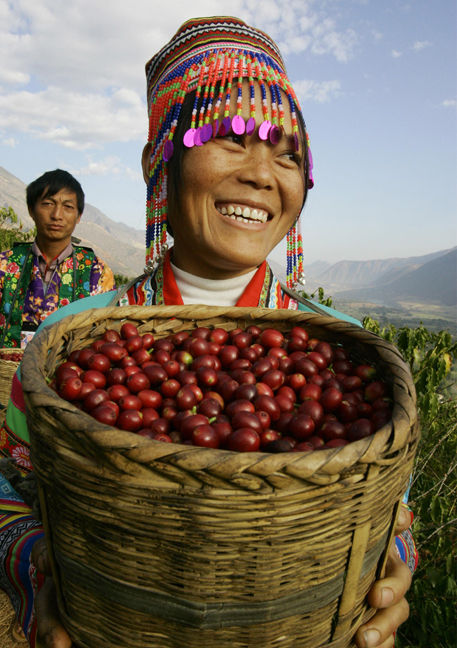In many ways, the eyes of the coffee world are on China. As a consuming country, it has the potential to destabilize the global industry but China is also starting to produce surprisingly large volumes of coffee. Growers are beginning to turn their attention to quality, pushing the boundaries of what is possible with the soil, climate and varieties found there.

Coffee was introduced to the Yunnan province by a French missionary in 1892. The story is that he crossed the border from Vietnam, bringing with him coffee seeds, and then planted them near his church in the village of Zhukula. For almost a hundred years, very little happened in the way of coffee production – unsurprising in a region famous for the amount, and quality, of tea it grows. In 1988, coffee production was invigorated in Yunnan, as part of a joint venture with the United Nations Development Program and the World Bank. Its success probably lies with the interest and support of Nestlé, which encouraged growth in the region.
Coffee production stayed relatively small until around 2009, when a significant jump occurred. This was probably due to a combination of lower tea prices and a brief spike in the global price of coffee. The coffee industry continues to grow in Yunnan, buoyed in particular by a growing market throughout China. Per capita consumption of coffee in China is still incredibly low, but its enormous population means the Chinese market has the potential to have an enormous impact on the supply and demand of coffee production worldwide.
Right now China is beginning to get a taste for its own coffee; the best Chinese coffee I have tasted was only available in China. Quality-based auctions are increasingly popular and prices being paid for locally grown coffee are very high. This makes China an unusual market, and certainly one to watch.
China is now exporting some excellent coffee, which is well worth seeking out. Many of the lots are still varieties chosen for disease resistance rather than taste, and there are still challenges to be overcome with the cultivation of more delicate varieties. However, I expect to see better and better every year.
means the Chinese market has the potential to have an enormous impact on the supply and demand of coffee production worldwide.
Right now China is beginning to get a taste for its own coffee; the best Chinese coffee I have tasted was only available in China. Quality-based auctions are increasingly popular and prices being paid for locally grown coffee are very high. This makes China an unusual market, and certainly one to watch.
China is now exporting some excellent coffee, which is well worth seeking out. Many of the lots are still varieties chosen for disease resistance rather than taste, and there are still challenges to be overcome with the cultivation of more delicate varieties. However, I expect to see better and better every year.
 Chinese farmers belonging to the Miao ethnic minority group harvest coffee beans at a plantation in Xinzhai village, Yunnan province, southwest China.
Chinese farmers belonging to the Miao ethnic minority group harvest coffee beans at a plantation in Xinzhai village, Yunnan province, southwest China.
TRACEABILITY
The best lots from China can come from a single farm or from a group of producers. These are absolutely worth seeking out, despite the fact that China does not yet have the pedigree and expectation of quality that other producing countries have.
TASTE PROFILE
The better coffees coming from China have a pleasant sweetness and fruitiness, though many still carry a little woodiness or earthiness too. Relatively low in acidity and often relatively full-bodied.
GROWING REGIONS
Population: 1,370,000,000
Number of 60kg (132lb) bags in 2016: 2,200,000
While the growing regions in China cover a relatively small area of the country, they still cover vast amounts of land. Coffee has plenty of room to grow in China, both in terms of production and consumption.
YUNNAN
The area where coffee was first grown in China remains the primary producing region for high-quality coffee in the country. The region is well known for Pu’er tea, and coffee production is now a key part of that same area.
| Altitude: | 900−1,700m (3,000–5,580ft) |
| Harvest: | October–January |
| Varieties: | Catimor, with some Caturra and Bourbon |
FUJIAN
This area is best known as a tea producer, home to Oolong and other teas. Coffee is a smaller industry in the region, and very little high-quality coffee is produced there.
| Harvest: | November–April |
| Varieties: | Robusta |
HAINAN
Coffee was brought to the island in 1908, probably from Malaysia. Robusta is grown here in the southernmost province of China, though there is no real reputation for quality in the region.
| Harvest: | November–April |
| Varieties: | Robusta |
 A modern coffee shop housed in a traditional building in Souzhou, in the southeast of Jiangsu Province.
A modern coffee shop housed in a traditional building in Souzhou, in the southeast of Jiangsu Province.